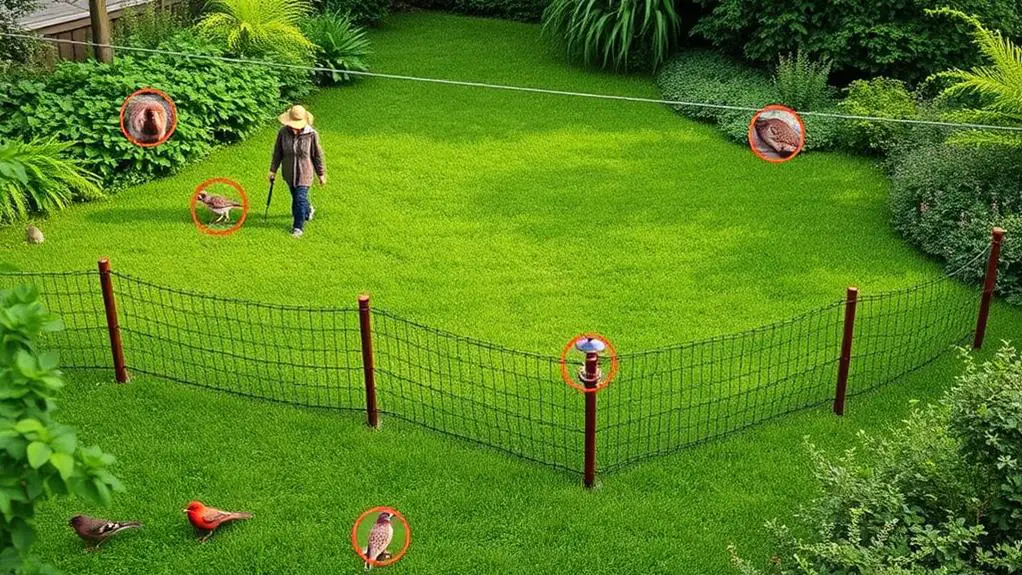How To Get Rid Of Ticks In Your Yard
I've been tackling the issue of ticks in my yard and found that a few strategic steps can make a significant difference. You'd be surprised at how much simply keeping your grass mowed and removing leaf litter can reduce tick habitats. But that's just the beginning. Creating barriers with gravel or wood chips, and even using natural remedies like essential oils, can further deter these pests. Have you ever thought about attracting wildlife that naturally controls ticks? There's more to explore, especially when it comes to combining these methods for a tick-free yard.
Understanding Tick Attraction

Ticks are drawn to our yards primarily because they hitch rides on wildlife like deer and rodents, which often find their way into residential areas. These animals bring ticks right to our doorsteps.
What attracts ticks the most are shady, moist areas such as leaf litter, tall grass, and low shrubs. Ticks love these spots since they provide the perfect environment for them to thrive and reproduce.
Rodents, especially mice, are frequent carriers that bring ticks into these favorable conditions. Understanding these factors helps us identify why ticks might be in our yards.
Recognizing these elements gives us a head start in managing our outdoor spaces and reducing tick populations effectively.
Yard Maintenance Strategies
To keep ticks out of your yard, start with regular mowing practices and keeping your grass short, around 3 inches or less.
This simple step limits their habitat and makes it harder for ticks to latch onto hosts.
Also, make sure to clear away leaf litter and debris, as these can provide the perfect moist hiding spots for ticks to thrive.
Regular Mowing Practices
Maintaining a well-manicured yard is one of the simplest yet most effective strategies to keep ticks at bay. Regular mowing keeps your grass short, which limits the tick habitat and makes it harder for ticks to find hosts. Aim to mow your lawn to a height of 3 inches or less and do it frequently, especially during spring and summer when ticks thrive in moist conditions.
While mowing, remember to:
- Trim grass along wooded edges and play areas to create safe barriers.
- Remove leaf litter and debris that provide moisture, which ticks love.
- Consider mowing twice a week during peak tick season to reduce infestations.
With these simple steps, you can enjoy a tick-free yard and feel confident letting your family play outside.
Leaf Litter Removal
When it comes to keeping ticks out of your yard, one of the most effective strategies is regularly removing leaf litter. By doing this, you'll reduce moisture levels, making your yard less inviting for ticks, which thrive in humid conditions.
Leaf litter serves as a habitat for ticks, so clearing it out can greatly decrease their survival rates. To maintain a clean yard, consistently bagging and disposing of leaves is essential.
It's best to do this at least once in the spring and fall, as these are peak activity periods for ticks. Using a rake to gather and dispose of leaf litter not only deters ticks but also improves the overall health of your yard.
Creating Barriers

Creating barriers in your yard is a great way to keep ticks at bay.
By laying down a 3 to 4-foot-wide border of gravel or wood chips around your lawn, you create a dry, exposed area that ticks don't like.
Regularly maintaining these borders not only keeps ticks out but also makes your yard look neat and tidy.
Install Gravel Pathways
Installing gravel pathways in your yard is a practical and effective method to create barriers that ticks are less likely to cross. By installing these pathways, you can keep ticks from moving into your lawn from wooded or brushy areas, reducing their presence.
Here's why gravel pathways work:
- Ticks avoid exposed areas: They prefer shaded, moist environments and steer clear of the exposed gravel.
- Rough texture: The gravel's rough surface is uncomfortable for ticks, deterring their movement.
- Easy maintenance: Regular upkeep keeps the area dry and free of debris, discouraging tick habitats.
Creating these pathways not only reduces the tick population but also provides clear routes for outdoor activities.
You'll feel more confident enjoying your yard without worrying about ticks.
Use Mulch Borders
Mulch borders are an effective way to create barriers that keep ticks at bay in your yard. By installing a 3-foot-wide barrier of wood chips or gravel, you can deter tick movement from nearby wooded areas. These mulch borders reduce moisture levels and create exposed areas that ticks avoid, as they prefer shady, humid conditions. Using broad, dry wood chips helps prevent tick crossings, making it hard for ticks to migrate into your lawn. Regular maintenance is essential since decomposing mulch can become new tick habitats. Here's a quick summary:
| Benefit | Description |
|---|---|
| Deterring Tick Movement | 3-foot-wide wood chip or gravel barrier |
| Reducing Moisture Levels | Less hospitable for ticks |
| Creating Exposed Areas | Ticks avoid these dry, sunny spots |
| Preventing Tick Crossings | Broad, dry wood chips are less inviting for ticks |
Tick Check Techniques
When it comes to keeping ticks at bay, regular tick checks are essential. It's important to inspect your body, pets, and clothing for ticks after spending time outdoors, especially from April to October when tick activity peaks.
Focus on areas like the scalp, behind the ears, underarms, and behind the knees.
Here's what I recommend:
- Use a flashlight to check shady, humid spots around your yard where ticks in your area might hide.
- Drag a light-colored cloth through grassy or wooded areas to reveal ticks clinging to the fabric.
- If you find a tick, remove it promptly with fine-tipped tweezers, grasping it close to the skin.
These steps can help you manage tick activity without needing a professional pest service.
Chemical Control Options

Are you wondering how to tackle tick infestations head-on? Chemical treatments are a solid option. By applying EPA-approved acaricides like permethrin or bifenthrin, you can kill up to 100% of ticks in treated areas.
It's essential to reapply these chemical treatments every 30 days during peak tick seasons, from April to September, to keep tick populations in check.
For effective tick management, consider ready-to-use sprays from trusted brands like Sevin, which target lawns and ornamental plants.
You can also use tick tubes filled with pesticide-treated cotton to reduce tick populations by targeting rodents.
Always follow safety guidelines to protect pets and children, ensuring areas are safely re-entered after treatment as recommended.
Natural Remedies
When it comes to natural remedies for ticks, essential oils like lavender, peppermint, and eucalyptus can be your best friends.
You can also introduce beneficial wildlife like free-range chickens to your yard, which love to snack on ticks.
These methods can create a safe and effective barrier without relying on harsh chemicals.
Essential Oils Efficacy
Essential oils like eucalyptus, lavender, and peppermint have proven to be effective natural remedies for keeping ticks at bay. These oils work as a great insect repellent, helping with tick control in your yard.
Studies show they can reduce tick attachment by up to 90%, which is impressive! When using essential oils, remember to dilute them with a carrier oil to avoid skin irritation. Reapply every few hours, especially after rain, to keep ticks coming back.
To make the most out of your tick management, don't forget:
- Yard Maintenance: Keep your grass short and remove leaf litter.
- Regular Reapplication: Essential oils need to be reapplied often.
- Thorough Plan: Combine natural alternatives with other prevention strategies.
This natural alternative can be a valuable part of your thorough plan!
Beneficial Wildlife Introduction
While essential oils offer a fantastic natural way to deter ticks, incorporating beneficial wildlife into your yard can further enhance your tick control efforts.
Introducing free-range chickens is a great start. Chickens forage for ticks, acting as natural pest control. You can also attract specific bird species, like guinea fowl and wild turkeys, which consume large quantities of ticks.
Amphibians, such as frogs and toads, also help by feeding on insects, including ticks. Planting native flora invites beneficial insects and wildlife, promoting a balanced ecosystem.
Additionally, providing habitats for natural predators like bats and reptiles can control tick populations by reducing small mammals that carry ticks.
These steps make your yard safer and more enjoyable.
Pet Care Measures

Taking proactive steps to protect your pets from ticks is vital for their health and well-being. Here are some effective pet care measures to take into account:
- Regularly treat pets with veterinarian-recommended tick prevention products, such as topical treatments or tick collars.
- Conduct thorough tick checks on pets after outdoor activities, especially in wooded or grassy areas.
- Keep pets away from high-risk tick habitats in your yard, like tall grass, dense shrubs, and leaf litter.
Maintaining a clean yard by mowing the grass and removing debris reduces tick habitats, helping to keep pets safe.
It's also important to be aware of the signs of tick-borne diseases like lethargy, loss of appetite, and joint swelling.
Take these steps to make sure your pets stay tick-free and healthy.
Landscaping for Tick Prevention
Keeping your yard tick-free starts with smart landscaping choices. Regularly mow your lawn to a height of 3 inches or less. Shorter grass reduces the habitat for ticks, which love tall grass.
Create a 3-foot wide barrier of wood chips or gravel around your yard. This limits tick movement from wooded areas into your lawn. Remember to remove leaf litter and debris often. These can hold moisture and provide shelter for ticks.
Planting deer-resistant species in your landscaping can deter deer, reducing tick presence. Also, incorporate xeriscaping techniques to minimize moisture and shade in your yard. Ticks thrive in humid environments, so keeping areas dry and sunny helps with tick prevention.
These steps make your yard a safer place.
Tick Host Management

Effective tick control goes beyond landscaping; it involves managing the animals that carry ticks into your yard.
Tick host management is key because deer and rodents are primary carriers. Deer can bring thousands of ticks, while rodents like mice harbor larvae and nymphs.
Here's what you can do:
- Install high fences to keep deer out, lowering the risk of tick introduction.
- Use permethrin-treated cotton in tick tubes. Rodents use the cotton for nesting, reducing the tick population.
- Encourage natural predators like birds and beneficial insects to control tick-carrying small mammals.
Professional Help
When it comes to tackling a serious tick problem, professional help can make a world of difference.
Professional pest control services use integrated pest management (IPM) strategies to reduce tick populations. They combine chemical and non-chemical methods, guaranteeing the safe use of EPA-approved acaricides. These treatments can kill up to 100% of ticks when applied correctly.
Experts conduct thorough inspections, identifying tick habitats and offering yard modification tips to prevent future infestations. Tailored treatments address your yard's specific conditions, providing ongoing protection.
Regular treatments from pest control experts can greatly lower the risk of tick-borne diseases for your family and pets. Trusting professionals guarantees a safer, more effective approach to keeping your yard tick-free.
Frequently Asked Questions
What Kills Ticks in the Yard?
To kill ticks in the yard, I use natural repellents like essential oils, maintain the yard, and choose smart landscaping. I also treat pets, set tick traps, and occasionally use chemical pesticides for effective control.
What Is the Fastest Way to Get Rid of Ticks?
The fastest way to get rid of ticks involves using EPA-approved acaricides. Effective tick prevention methods also include yard maintenance tips, natural tick repellents, and understanding the tick life cycle to guarantee thorough tick habitat reduction and pet tick protection.
What Attracts Ticks to the Yard?
Ticks are attracted to yards by host animals like deer and rodents, and thrive in tick habitats with high moisture levels, leaf litter, and tall grass. Effective yard maintenance, vegetation management, and wildlife barriers can help reduce their presence.
What Do Ticks Hate the Most?
Ticks hate natural repellents like essential oils, especially eucalyptus and peppermint. Effective landscaping tips include maintaining dry yards and using gravel barriers. For pet protection, try seasonal prevention and DIY solutions to eliminate tick habitats.
Conclusion
To sum up, keeping your yard tick-free takes some effort, but it's definitely doable. Start by keeping your grass short and removing leaf litter. Create barriers with gravel or wood chips, and consider using safe chemicals when needed. Don't forget to check your pets regularly for ticks. If you need extra help, don't hesitate to call in professionals. By taking these steps, you'll create a safer, more enjoyable yard. You've got this—happy gardening!






